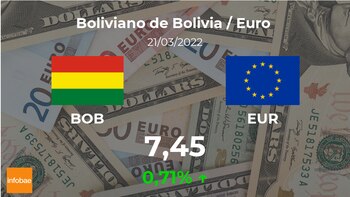
The euro was paid at the close to 7.45 Bolivianos on average, an increase of 0.71% compared to the previous day's figure, when it traded at 7.40 Bolivianos on average.
Compared to the last seven days, the euro accumulated a rise of 0.93%; but in the last year it still accumulated a decrease of 9.23%. Comparing this data with that of previous days, he accumulated four consecutive days of climb. The volatility of the last seven days is somewhat higher than the data obtained for the last year (7.37%), so it is showing a more unstable behavior.
In the annual photo, the euro has reached a maximum of 7.76 Bolivianos on average, while its lowest level has been 7.28 Bolivians on average. The euro is closer to its minimum than its maximum.
Among the uncertainty
The Bolivian has been the legal tender of Bolivia since 1987 and is divided into 100 cents, formerly the Bolivian peso was used but it was replaced. The Central Bank of Bolivia is the body responsible for regulating the issuance of currency.
The coins of 10, 20 and 50 cents are currently in circulation, as well as 1, 2 and 5 Bolivianos. In 1988 a Bolivian was equal to one US dollar.
As for creation, the Bolivian currency stopped its minting and printing during colonial times due to a lack of political interest, which would eventually cause coins and banknotes to be created abroad because of the low price that this implies. In 2013 they were still manufactured in countries such as the United Kingdom, France and Chile.
Regarding the economy, in 2014 Bolivia resorted to high public spending and increasing domestic credit to maintain its growth, but these measures resulted in an increase in public debt and the reduction of international reserves.
Like all over the world, the coronavirus pandemic hit Bolivia's economy severely, although inflation was not as high as in other Latin American nations, closing 2021 with 0.90 percent.
According to projections made this year by the World Bank, Bolivia will grow by only 3.7% by 2022, however, President Luis Arce has challenged these forecasts and assured that Gross Domestic Product (GDP) could grow by as much as 6%.
Inaddition, the country closed 2021 with a trade surplus of $1.471 million, the first in the last six years, where annual negative balances were recorded in the balance. In addition to these conditions, unemployment has increased by 5.2 per cent.
Bolivia is also facing global efforts to move to clean energy, so these conditions will prompt one of the largest gas-exporting countries to seek alternatives.
Agencies
Últimas Noticias
Debanhi Escobar: they secured the motel where she was found lifeless in a cistern

The oldest person in the world died at the age of 119

Macabre find in CDMX: they left a body bagged and tied in a taxi
The eagles of America will face Manchester City in a duel of legends. Here are the details

Why is it good to bring dogs out to know the world when they are puppies




